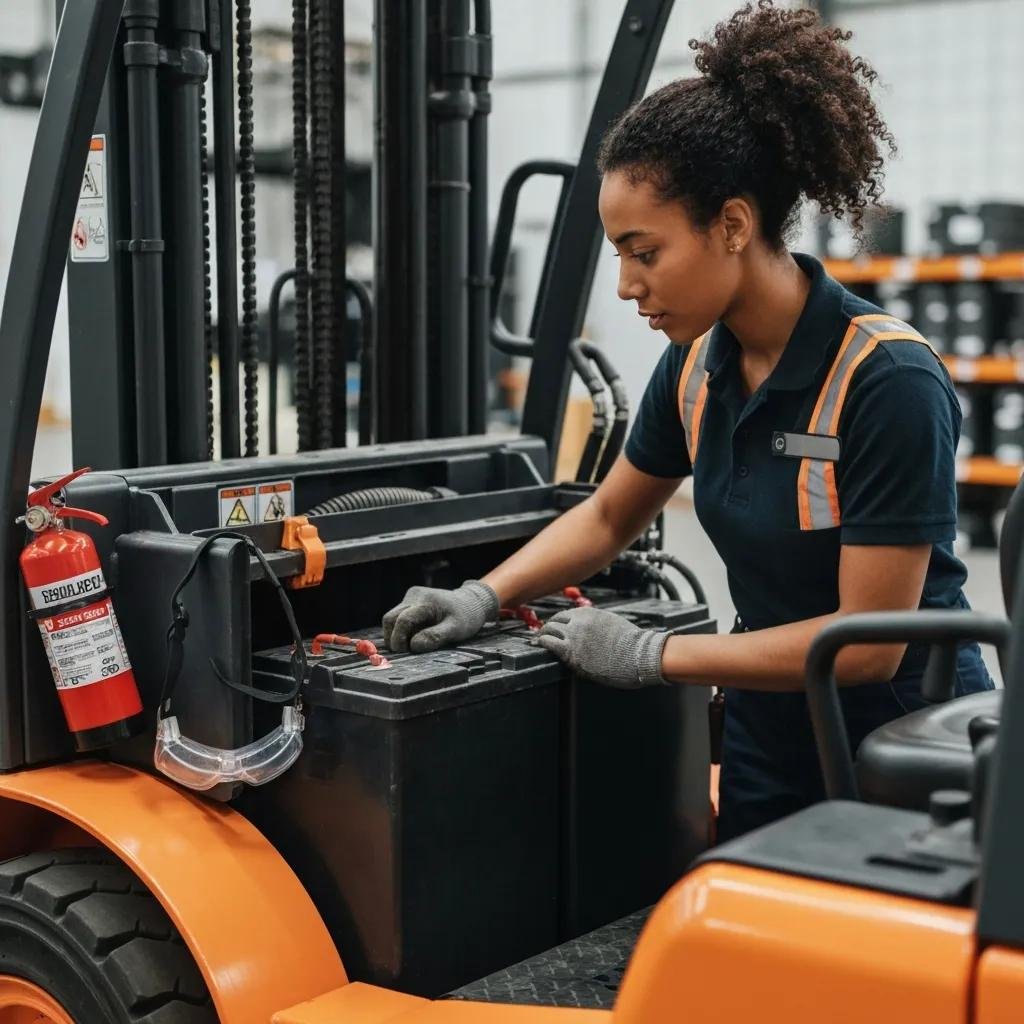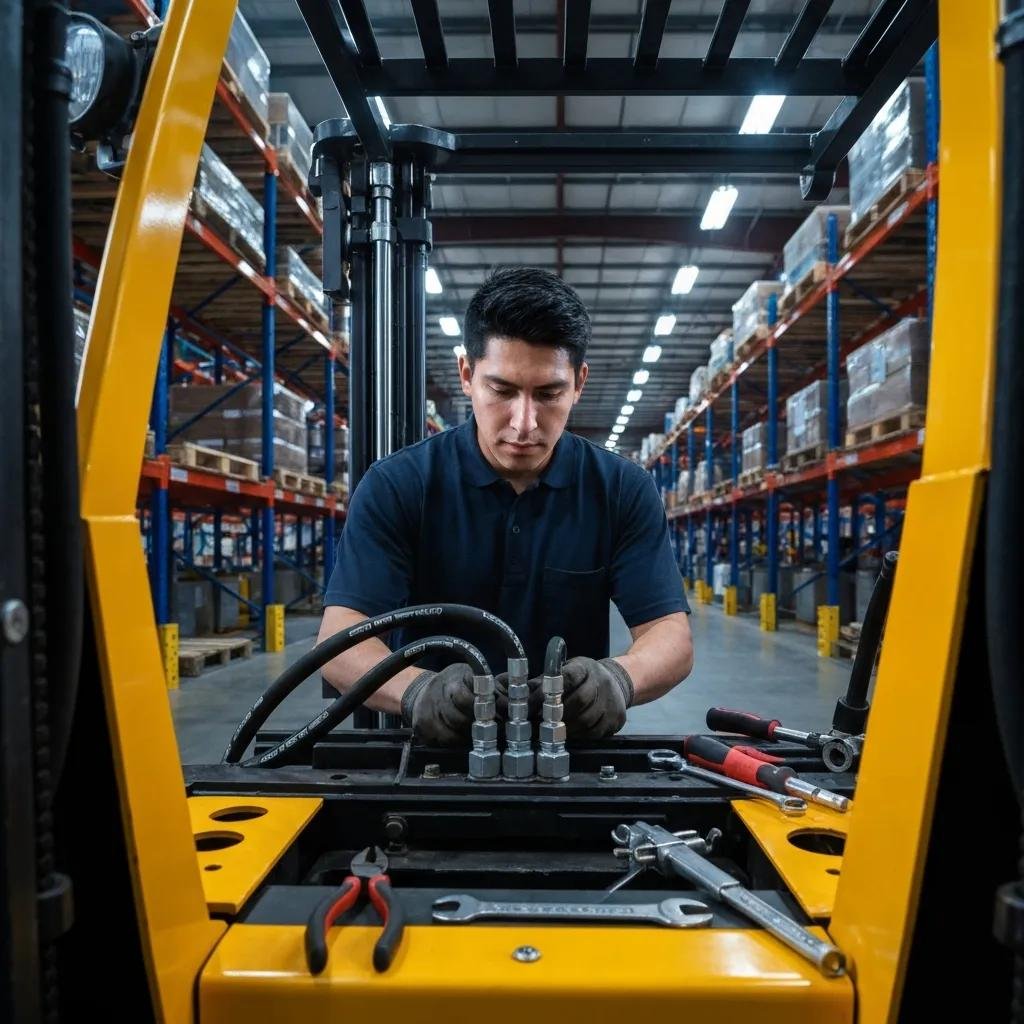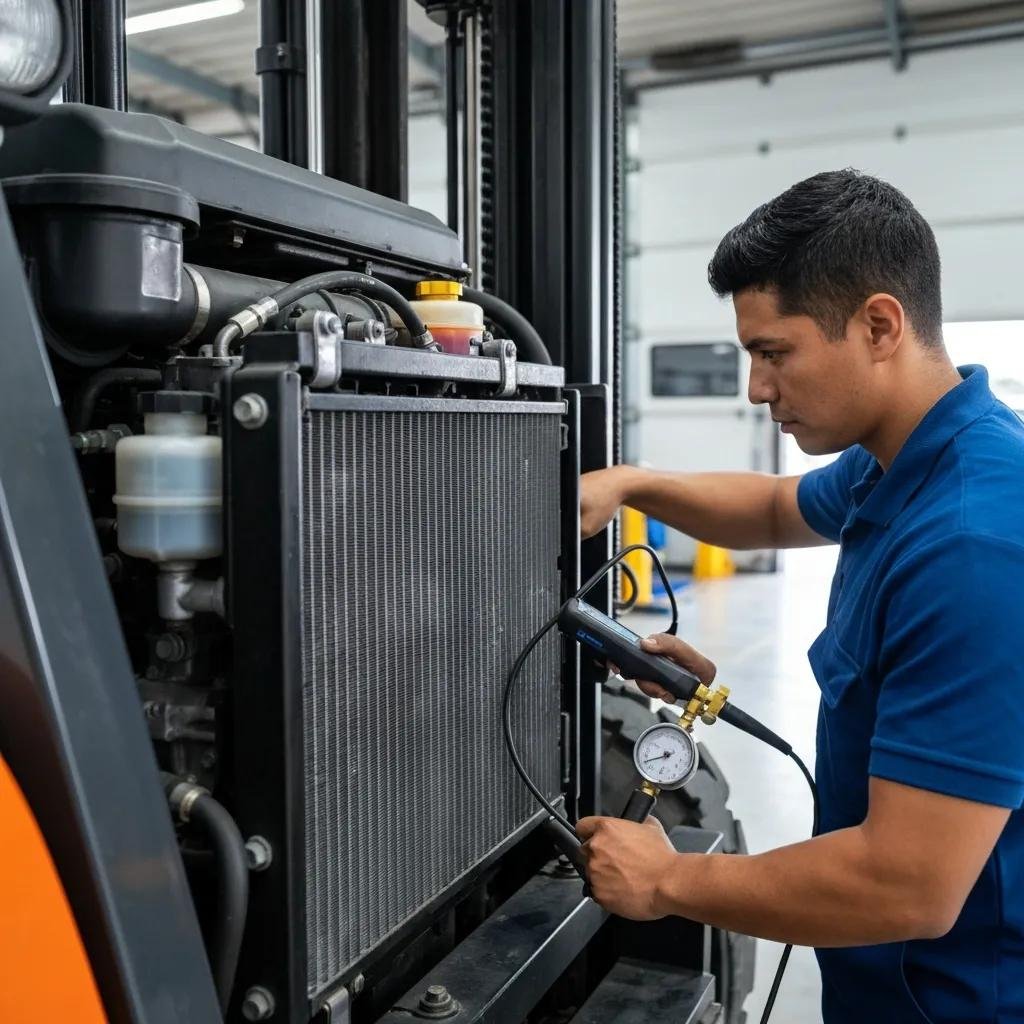
Top 5 Common Forklift Repair Issues Businesses in Houston Face and How to Fix Them
Houston warehouses and job sites rely on forklifts to move heavy loads quickly, but common mechanical and electrical faults can erode uptime, increase costs, and create safety risks. This article explains the five most frequent forklift repair issues Houston businesses face—battery failures, hydraulic leaks, engine overheating, brake malfunctions, and tire wear—then provides practical, step-by-step diagnostics and field fixes you can apply before scheduling professional service. You will learn symptom checklists, prioritized troubleshooting steps, preventive actions that reduce recurring failures, and indicators that require escalation to a certified technician. As you read, the guide references Houston-specific factors like heat and humidity and integrates best practices for Crown, Hyster, Komatsu, Toyota, and Yale equipment. For local expertise, Upright Forklift Repair provides certified technicians and on-site emergency response across Houston and Humble; their contact options and service details can help reduce costly downtime when DIY measures are insufficient.
Understanding the specific type of forklift, such as a reach truck, is crucial for both operation and maintenance. Each model has unique characteristics that influence its repair needs and operational efficiency.
What Are the Most Common Forklift Battery Problems in Houston and How Can You Fix Them?
Forklift battery problems in Houston typically present as no-start conditions, rapid loss of runtime, or charging irregularities caused by electrolyte imbalance, corroded terminals, or aged cells. High ambient temperatures in Houston accelerate water loss and sulfation in lead-acid batteries, reducing capacity and runtime; proper charging and watering routines mitigate these mechanisms and extend battery life. The practical benefit of early detection is predictable shift coverage and fewer emergency swaps, which lowers operational disruption. Below are diagnostic actions and a quick comparison table to help techs and operators triage battery faults on the floor.
Different battery failures map to fast field checks and straightforward fixes:
| Battery Issue | Symptom | Immediate Fix |
|---|---|---|
| Dead battery | Unit won’t start, voltage near 0 V | Confirm charger connection, attempt controlled recharge |
| Rapid discharge | Short runtime, heavy voltage sag under load | Check state of charge, perform load test, inspect for sulfation |
| Terminal corrosion | White/green deposits, poor clamp contact | Clean terminals, tighten clamps, apply anti-corrosion compound |
| Swollen cells | Case distortion or leakage | Remove from service and schedule replacement |
This table helps prioritize which units need in-shop replacement versus on-site conditioning or terminal service. Regular monitoring of voltage under load plus inspection for physical damage gives early warning and prevents sudden failures.
What Symptoms Indicate Forklift Battery Problems in Houston?
Operators in Houston should watch for clear battery symptoms that indicate declining performance and imminent failure. Common signs include slow or no cranking, noticeably shorter shift runtime, and visible terminal corrosion or electrolyte buildup on cell caps. You can run a quick voltage check and a load test with a handheld meter to determine if the battery holds charge under operating load; low open-circuit voltage and excessive voltage drop under load point to internal cell failure or sulfation. Because Houston heat evaporates electrolyte faster, also check water levels in flooded lead-acid cells and look for bulging cases, which require immediate removal from service to avoid acid leaks and safety hazards.
How Do You Diagnose and Repair Forklift Battery Issues?
Diagnosing battery faults follows a short, repeatable sequence that isolates charger, battery, and cabling faults. First, verify charger output and connections, then measure battery open-circuit voltage and perform a load test while observing voltage sag and recovery. If terminals are corroded, de-energize, disconnect, and clean with a baking-soda solution then re-tighten clamps to manufacturer torque specs; top off cells with distilled water if required and allowed by battery type. If load tests show failing cells or capacity below manufacturer thresholds, plan for battery replacement and ensure disposal follows local regulations. Regular charger maintenance and adherence to charging cycles reduce sulfation and optimize battery lifespan.
For persistent or complicated battery failures—especially on major brands like Crown or Toyota—call Upright Forklift Repair for certified Houston technicians who handle on-site diagnostics and battery replacement while minimizing downtime.
How to Identify and Repair Hydraulic System Leaks and Lift Failures in Houston Forklifts?

Hydraulic leaks and weak lifting power occur when seals, hoses, fittings, or cylinders degrade, allowing fluid loss and pressure drop that reduce lift speed and load-holding ability. The mechanism behind these failures is typically abrasive contamination, seal wear, or heat-accelerated fluid breakdown; contaminated hydraulic fluid accelerates seal abrasion and corrodes metal surfaces. Repair restores lift performance and safety, often by replacing compromised hoses or seals and flushing contaminated fluid. Quick diagnosis saves load incidents and prevents progressive damage to pumps and valves.
Recognizing leak types and recommended actions helps prioritize field repairs:
| Leak Type | Affected Component | Recommended Action |
|---|---|---|
| Hose leak | Flexible high-pressure hose | Replace hose, inspect clamps, torque fittings to spec |
| Seal leak | Cylinder rod seal | Remove cylinder, replace seals, polish rod if scored |
| Fitting leak | Hydraulic fitting or adapter | Tighten to torque, replace damaged fitting or seat |
| System contamination | Fluid cloudiness, particulate | Flush system, replace filters, refill with specified fluid |
This mapping clarifies whether the repair is a quick onsite hose swap or a scheduled shop rebuild, and it emphasizes using manufacturer-specified hydraulic fluid to avoid compatibility issues.
What Are the Signs of Hydraulic Leaks and Weak Lifting Power?
Operators will notice slower than normal lift speed, audible hissing, visible fluid drips, or cylinders that fail to hold a load—each sign of compromised hydraulic integrity. Inspect fluid level and color; dark or milky fluid suggests contamination or water ingress and indicates immediate system flush. Check hoses for abrasions, bulges, or chafing at clamps, and examine rod surfaces for scoring that damages new seals. Because hydraulic failures can drop loads unexpectedly, restrict operation until the system is diagnosed and secure, and log the defect for maintenance scheduling.
What Steps Fix Hydraulic System Leaks and Prevent Future Failures?
Start repairs by isolating the hydraulic circuit and relieving pressure, then replace damaged hoses, seals, or fittings using OEM-spec components and correct torque values for fittings. After parts replacement, purge air from the circuit, change the hydraulic filters, and refill with manufacturer-recommended hydraulic fluid to restore viscosity and corrosion protection. Implement contamination control: install proper breathers, ensure clean reservoir fills, and schedule filter changes at recommended intervals. Keep records of component changes to detect repetitive failure modes and adjust maintenance frequency accordingly.
If a leak or lift failure is complex, or if a cylinder or pump rebuild is required, Upright Forklift Repair offers on-site diagnostics and repairs across Houston and Humble to restore hydraulic performance with certified parts and trained technicians.
Why Do Forklift Engines Overheat in Houston and What Are the Best Fixes?

Forklift engine overheating in Houston commonly stems from low coolant levels, clogged radiators, failed fans or thermostats, and heavy ambient heat that stresses cooling systems. The mechanism is reduced heat rejection: blocked airflow or degraded coolant prevents heat transfer from the engine, producing high operating temperatures and potential engine damage. Fixing overheating prevents seize, head gasket damage, and downtime, yielding direct operational and cost benefits. Below are the primary causes and a concise troubleshooting sequence to identify quick fixes and when to escalate.
Common causes of overheating in Houston include:
- Low coolant level or coolant leaks that reduce circulation.
- Clogged radiator fins or external debris blocking airflow.
- Failed fan clutch, belt, or thermostat preventing proper coolant flow.
- Water pump failure or degraded coolant losing corrosion protection.
What Causes Forklift Engine Overheating and Stalling in Houston?
Heat load from the Houston climate increases baseline cooling demand and exposes weak cooling components, while mechanical causes like leaks, blocked radiators, and failed pumps reduce cooling capacity. Contaminated or old coolant can lose its boiling point elevation and corrosion inhibitors, leading to localized hotspots and head gasket failures. Additionally, a slipping fan belt or failed clutch reduces airflow across the radiator, limiting heat rejection during heavy duty cycles. Recognizing how ambient heat compounds mechanical wear helps prioritize checks on coolant level, radiator cleanliness, fan operation, and belt condition.
How Can You Troubleshoot and Repair Engine Overheating Issues?
Troubleshooting begins with safe shutdown and cool-down procedures, followed by visual inspection of coolant level, radiator fins, hoses, and drive belts. Pressure-test the cooling system to locate hidden leaks, inspect the thermostat and fan clutch for proper engagement, and verify water pump integrity and coolant condition—replace coolant if oxidized or contaminated. Temporary field fixes include topping off coolant and clearing debris from the radiator, but persistent overheating or pressure loss requires component replacement and system flushes. If overheating continues after these steps, schedule professional inspection to prevent catastrophic engine damage.
When overheating persists or you suspect head gasket or pump failure, contact Upright Forklift Repair for on-site troubleshooting and engine cooling repairs tailored to diesel, propane, and gasoline forklifts in the Houston area.
What Are Common Forklift Brake System Malfunctions in Houston and How Are They Resolved?
Brake problems commonly manifest as a soft pedal, reduced stopping power, squealing noises, or dragging brakes caused by worn pads/shoes, contaminated brake fluid, or incorrect adjustments. The mechanism is either friction material depletion or hydraulic system compromise, and the effect is extended stopping distances and safety hazards that must be addressed immediately. Effective resolution includes inspection, replacement of worn components, bleeding contaminated fluid, and recalibration to manufacturer settings to restore reliable stopping performance.
Brake symptoms that operators should monitor include:
- Soft or spongy pedal feel when braking.
- Audible grinding, squeal, or metallic noise on application.
- Increased stopping distances or brake drag after release.
How Do You Recognize Brake Problems Like Soft Pedals or Squeaking?
Detect soft pedals by observing pedal travel and firmness during a controlled stop; excessive travel or a spongy feel often indicates air in the hydraulic lines or low fluid. Squealing may come from glazed pads, foreign debris, or misalignment of shoes, and a scraping or grinding noise usually means metal-on-metal contact requiring immediate removal from service. Check the brake fluid reservoir for level and contamination color; dark or murky fluid suggests moisture or contamination and merits a full system bleed and fluid change per OEM intervals. Immediate recognition and restriction of use prevent compounding safety risks.
What Are Effective Repairs and Maintenance for Forklift Brakes?
Address brake faults by replacing worn pads or shoes and resurfacing or replacing rotors/drums when scoring or excess wear is present, then bleed the system to remove air and replace contaminated fluid with manufacturer-specified brake fluid. Adjust mechanical linkages to restore proper shoe clearance and inspect parking brake mechanisms for proper engagement. Establish a scheduled brake inspection interval and keep records to detect accelerated wear patterns caused by overloading or severe duty cycles. For compliance and safety, document inspections per OSHA forklift safety guidance and follow OEM torque and adjustment specifications.
If hydraulic brake bleeding, shoe replacement, or drum/rotor servicing is beyond in-house capability, Upright Forklift Repair provides professional brake servicing and safety checks for Houston operators.
How to Detect and Fix Forklift Tire Wear and Damage for Houston Businesses?
Forklift tire wear and damage reduce traction, ride quality, and stability; causes include misalignment, heavy or unequal loads, abrasive surfaces, and environmental damage. The mechanism is uneven stress distribution that accelerates tread loss or exposes cords, increasing puncture risk and vibration. Fixing tire issues restores safe handling and load control and improves operator comfort. This section helps you recognize wear patterns, choose the correct tire type for Houston operations, and balance repair versus replacement.
| Tire Type | Best Use Case | Maintenance / Replacement Notes |
|---|---|---|
| Solid (cushion) | Indoor smooth concrete | Long life, resists flats, replace when tread loss affects stability |
| Pneumatic | Outdoor rough or uneven terrain | Better shock absorption, inspect for cuts and proper inflation |
| Cushion | Tight indoor spaces with smooth floors | Lower profile for stability, monitor for chunking and edge wear |
What Causes Forklift Tire Wear and What Are the Warning Signs?
Common causes of tire wear include repeated heavy loads, misalignment, uneven floor surfaces, and abrasive debris; warning signs include uneven tread depth, exposed cords, bulges, or recurring vibration during travel. Inspect tires daily for cuts, embedded debris, and consistent tread depth across axles. Uneven wear between left and right sides often points to alignment or steering issues that require correction to avoid premature replacement. Timely detection reduces the frequency of full tire changes and prevents stability hazards.
How Do You Choose and Maintain the Right Forklift Tires in Houston?
Select tires based on operating surface, load characteristics, and indoors/outdoors use: solid cushion for smooth indoor concrete, pneumatic for outdoor rough ground, and specialty compounds for abrasive yards. Implement maintenance tasks such as regular pressure checks for pneumatic tires, scheduled rotation when applicable, and prompt replacement when cords are exposed or structural defects appear. For on-site emergencies like a flat or severely damaged tire, temporary removal and replacement with a spare can keep critical operations moving until a full replacement is installed. When in doubt about matching tire compounds to load cycles, consult a local technician experienced with major brands and Houston conditions.
For assistance selecting tires, conducting on-site inspections, or arranging replacement to minimize downtime, Upright Forklift Repair can evaluate your fleet and recommend the appropriate tire strategy for Houston and Humble operations.
How Can Preventative Maintenance Reduce Forklift Repair Issues for Houston Businesses?
Preventative maintenance (PM) is a scheduled program of inspections and service tasks designed to detect wear and correct faults before they cause failure; it reduces repair frequency, extends component life, and lowers total cost of ownership. The mechanism is early detection: routine checks of batteries, hydraulics, cooling, brakes, and tires reveal trends, enabling targeted interventions that prevent sudden breakdowns. Implementing a PM program delivers measurable outcomes—fewer emergency repairs and more predictable uptime—and fits easily into shift schedules with short daily checks and periodic professional servicing.
Essential preventative maintenance tasks local to Houston include a blend of daily checks and interval services:
- Daily pre-shift walkaround: fluid levels, battery electrolyte, visible leaks, tire condition, and brake feel.
- Weekly inspections: charging routines, hose and fitting checks, and radiator/air intake cleaning.
- Monthly or hourly-based services: hydraulic fluid analysis, brake system bleed and inspection, belt tension, and complete battery load tests at OEM intervals.
Daily checks are brief but effective at preventing avoidable breakdowns. Summarize findings in a log to track recurring issues.
Daily PM checklist to perform before each shift:
- Check battery charge, electrolyte level, and terminal condition.
- Inspect hydraulic hoses, fittings, and fluid level for leaks.
- Confirm coolant level, radiator cleanliness, and fan belt condition.
- Test brakes for firmness and inspect tire surfaces for damage.
What Are Essential Preventative Maintenance Tasks for Houston Forklifts?
Essential tasks include daily operator checks, scheduled battery watering and charging discipline, hydraulic fluid and filter changes at manufacturer intervals, cooling system flushes and radiator cleaning, brake inspections and fluid replacement, and tire inspections/rotations as needed. Implementing an interval-based schedule—daily, weekly, and at fixed hour thresholds (e.g., every 100–200 hours)—ensures maintenance touches every major system before wear becomes critical. Documenting each task creates an operational history that helps isolate systemic problems and justify PM investments using data.
How Does Regular Maintenance Lower Repair Costs and Downtime?
Regular maintenance lowers repair costs by shifting expensive reactive repairs into planned, lower-cost interventions that extend component life and prevent collateral damage; documented programs commonly show significant reductions in emergency service calls and unplanned downtime. Predictable maintenance scheduling improves fleet availability and allows managers to plan around service windows, reducing rush replacement premiums and overtime. By investing in PM, businesses in Houston protect against climate-accelerated wear, maintain safety compliance, and achieve a measurable return in reduced repair spend and improved productivity.
For businesses ready to implement or scale preventative maintenance plans—especially those needing emergency response or on-site service in Houston and Humble—Upright Forklift Repair provides certified technicians, preventative maintenance packages, and emergency repair availability; contact them by phone at (346) 559-8290 or via their online service listings and Google Business Profile for scheduling and plan details.
